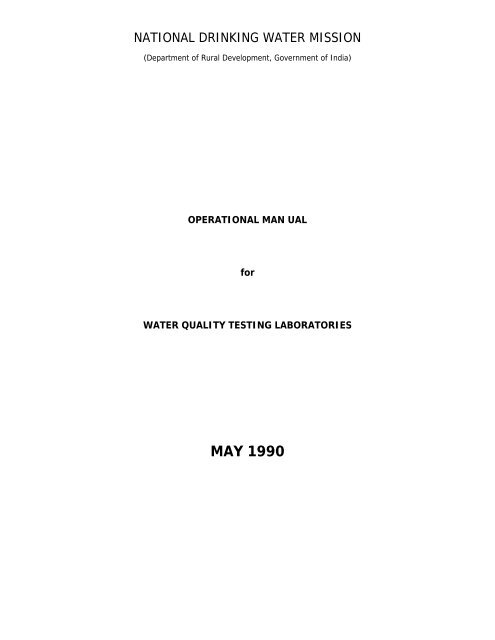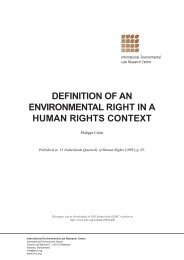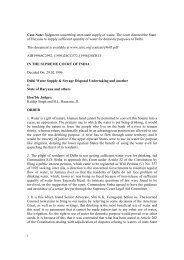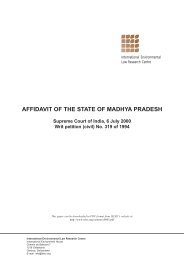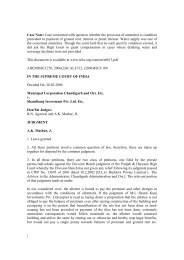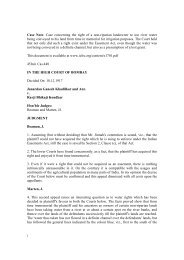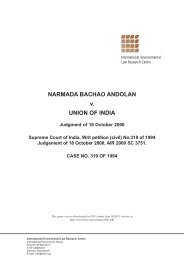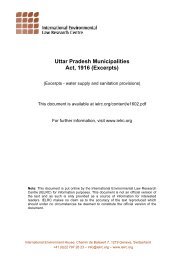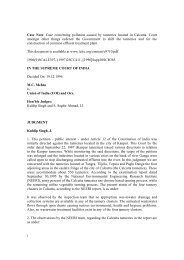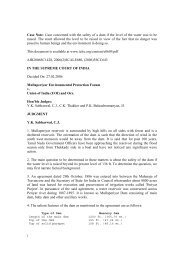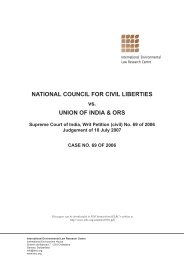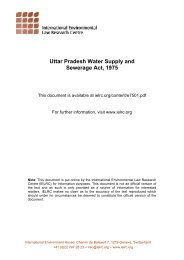Operational Manual for Water Quality Testing Laboratories, 1990
Operational Manual for Water Quality Testing Laboratories, 1990
Operational Manual for Water Quality Testing Laboratories, 1990
Create successful ePaper yourself
Turn your PDF publications into a flip-book with our unique Google optimized e-Paper software.
NATIONAL DRINKING WATER MISSION(Department of Rural Development, Government of India)OPERATIONAL MAN UAL<strong>for</strong>WATER QUALITY TESTING LABORATORIESMAY <strong>1990</strong>
CONTENTSSl. No. Item Page No.1. SAFETY PRECAUTIONS IN LABORATORIES 12. DO’s AND DON’Ts IN LABORATORIES 43. SAMPLING 54. RECEORDING AND REPORTIONG DATA 75. PROCEDURE FOR ANALYSIS OF VARIOUS9PARAMETERS6. PROFORMA FOR MONTHLY REPORTING OF 27FUNCTIONS OF DISTRICT LABORATORY7. LIST OF DOCUMENTS TO BE MAINTAINED 29
ISAFETY PRECAUTIONS IN LABORATORY1.1 Precautions with Hazardous Chemicals:- All containers must be clearly labeled and read be<strong>for</strong>e opening. Ifdispensing into another contained, put label alongwith warning.- Minimal stocks not exceeding 500 ml of corrosive or flammablesolvents only may be kept in work room. Keep in safe place inplastic covered metal cabinet.- Glacial acetic acid must be regarded as a flammable solvent.- Ether and low boiling point flammable liquids must not be kept infridge.- Large container of corrosive or flammable liquids should never beput on high shelves or where they can be knocked down or fall.Never put liquids that react violently together closely.- Never carry bottles by neck alone. Open bottles with care.- When diluting concentrated sulphuric acid or other strong acids, itshould be added to water in heat resistant vessel.
1.2 Spillage of Hazardous Chemicals- If amount is small, dilute with water or detergent. It amount islarge protective apron, rubber gloves and boots are worn andtreatment carried out according to wall chart showing how tomanage chemical spillage.- Hydrochloric acid and sulphuric acid can be neutralized withanhydrous sodium carbonate then shovelled into a plastic bucketwhich is subsequently diluted by water and run to waste. Ammoniasolution, ethanol, methanol and <strong>for</strong>malin are best treated bydiluting with water, collection and running to waste. Windowsmust be opened. Phenols must be diluted with atleast 20 times thevolume of tap water be<strong>for</strong>e running to waste.1.3 First AidThe First Chart should be mounted on a nearby wall. The first aid boxmust be accessible with Laboratory Staff. An emergency eye wash bottlewith a bottle of sterilised water should be readily available. A Universalpoison antidote is useful. Activated aluminium oxide or a tin ofevaporated milk should be readily available. A tin opener and some waterproof dressing material should also be readily available.1.4 Avoidance of Hazards of Equipment- Trained staff should operate the equipments.- Operating instructions should be followed.
IIDO’S AND DON’T IN LABORATORY- NEVER EAT, SMOKE OR DRINK IN LABORATORY- NEVER MOUTH PIPETTE- WASH HANDS BEFORE STARTIANG WORK, PREFERABLY WEAR ACLEAN LABORATORY COAT.- REGULARLY CLEAN WORKING AREA WITH DISINFECTANT.- USE ONLY MEDIA AND EQUIPMENT KNOWN TO BE STERILE.- NEVER TOUCH PART OF PIPETTE TUBES ETC., WHICH WILL COMEIN CONTACT WITH STERILE SAMPLE.- OPEN TUBES OR PETRI DISHES FOR MINIMUM TIME.- ALL CULTURES TUBES, PETRI DISHES SHOULD BE AUTOCLAVEDBEFORE DISPOSAL OR RELEASE FOR WASHING UP.- ALL USED PIPETTES MUST BE DISCARDED BY IMMERSING INDISINFECTANT (e.g. > SAVLON) JARS FILLED TO ALLOW ALMOSTCOMPLETE IMMERSION. CHANGE DISINFECTANTLY DAILY.- AVOID SPLASHING INFECTIOUS MATERIAL CREATING AEROSOLSOR DISPERSING INFECTIOUS MATERIAL INTO THE ENVRONMENT.
IIISAMPLING3.1 It is well recognized that the result of any test procedure can be nobetter than the sample on which it is per<strong>for</strong>med. The objective ofsampling is to collect a portion of material small enough in volumewhich can be transported easily and handed in the laboratory whilestill accurately representing the material being collected.3.2 The sampling programme defines the portion of the whole to whichrest results apply. The variations of the whole material withrespect to time, area, depth, and occasionally, rate of flow must betaken into consideration to ensure representative nature of thesample. It is not possible to specify detailed procedure <strong>for</strong>collection of all types of samples. However, a general guidelines assuggested below may be followed:3.3 General Guidelines and Precautions- Collect a sample that con<strong>for</strong>ms to the requirements of the samplingprogramme and handle it carefully so that it does not deteriorate or getcontaminated during its transport to the laboratory. Be<strong>for</strong>e filling thecontainer rinse it two or three times with the water being collected.Representative samples of some sources can be obtained only be makingcomposites of samples collected over a period of time or at a number ofdifferent sampling points.- While collecting a sample from the distribution system, flush linesadequately, taking into consideration the diameter and length of the pipeto be flushed and the velocity of flow.
- Collect samples from tube-wells only after sufficient pumping toensure that the sample represents the ground water source.- When samples are to be collected from a river or stream, analyticalresults may vary with depth, flow, distance from the shore and from oneshore to the other. If equipments are available <strong>for</strong> collection of“integrated” sample from top to be bottom in the middle of the streamand composite the sample according to the flow, Grab or catch sampleshould be collected in the middle of the stream and at mid depth.- Since lakes and reservoirs are generally undergo considerablevariation due to normal natural causes, choose location, depth andfrequency of sampling depending on local conditions and the objective ofthe study.- Make detailed record of every sample collected and identify eachcontained by attaching a tag or label. Record in<strong>for</strong>mation like date, timeand exact location, weather condition, stream-flow etc.3.4 <strong>Quality</strong> of Sample to be CollectedNormally a 2-litre sample would be sufficient <strong>for</strong> most physical andchemical tests. Never use the sample <strong>for</strong> chemical, bacteriological andmicroscopic examinations, because collection and test procedures <strong>for</strong> thelatter tests are different.3.5 Time Interval between Collection and Analysis.The interval between collection and analysis of the sample should beshortest possible.
IVRECORDING AND REPORTING OF DATA4.1 The District Laboratory shall keep records of submitted samples andcompleted analysis in a manner that provides <strong>for</strong> the data retrievability,the sample preservation and the persons responsible <strong>for</strong> the sampling andanalysis. All laboratory data sheets shall be dated and signed by theanalysts and the Head of the Laboratory or his designee.4.2 Electrical conductivity, pH, temperature, and turbidity should be recordedin units specified <strong>for</strong> the respective tests and the results of other chemicalexaminations shall be expressed in terms of substances or ions actuallydetermined and reported as milligram per litre, which may be considered<strong>for</strong> all practical purposes as equivalent to parts per million (ppm).4.3 A commonly used and functional method of recording laboratory data is anote book specifically printed <strong>for</strong> this purpose. The pages are seriallynumbered in pairs with a carbon between the pages to provide matchingserial numbered copy of the data. These books are permanently boundbut the duplicate page is per<strong>for</strong>mated <strong>for</strong> easy removal. The duplicatepage may then be filed in a system wherefrom it may be readily retrieved.The pages of the note book are generally lined in a grid pattern withprovision <strong>for</strong> such in<strong>for</strong>mation as project identification, data, reference tothe analytical procedure, the observations, sample calculations, as mg/1and signature of the analyst.
4.4 Analytical <strong>Quality</strong> ControlThe basic objective of a water analysis laboratory is to produce accuratedata describing the physical-chemical characteristics of water samplesunder study. <strong>Quality</strong> assurance is the total programme <strong>for</strong> assuring thereliability of analytical data. Items discussed in this document can all beconsidered as contributing to the overall programme of quality assurance.Another essential component of a quality assurance is analytical qualitycontrol which refers to the routine application of procedures <strong>for</strong> controllingthe measurement process.4.4 Internal quality control or statistical quality control is the most importantcomponent of any laboratory quality control programme. Experienceindicates that 10-20% of the resources of a laboratory should be devotedto such work. Suitable approaches to internal quality control should befollowed.4.5 External quality control is best applied after incorporating internal qualitycontrol practices in the laboratory, and consists in the periodic analysis ofreference samples. These reference samples may not be different fromthe control samples which the laboratory has been preparing <strong>for</strong> its ownuse, with the exception that the amount of each substance present isunknown to the analysts.
VPROCEDURE FOR ANALYSISOF VARIOUS PARAMETERS5.1 ColourThe platinum cobalt method of measuring colour is the standard method,the unit of colour being that produced by 1 mg platinum/ litre in the <strong>for</strong>mof chloroplatinate ion. It is applicable to measure the colour of potablewater and of water in which colour is due to naturally occurring materials.Even a slight turbidity effects the colour. Remove turbidity bycentrifugation <strong>for</strong> 1 hours. As colour varies with pH, specify the pH atwhich colour is measures.Field MethodAs the platinum-cobalt standard method is not convenient <strong>for</strong> field use,compare water colour with that of glass discs held at the end of metallictubes containing glass comparator tubes filled with sample and colourlessdistilled water. Match sample colour with the colour of the tube of clearwater plus the caliberated coloured glass when viewed by looking towardsa white surface.Collect representative samples in clean glassware and make the colourdetermination within a reasonable period.
Appratusa) Nessler tubes, 50 ml, tall <strong>for</strong>mb) pH – meterPreparation of standardsDissolve 1.246 g potassium chloroplatinate, K 2 PtCl 6 (equivalent to 500 mgmetallic Pt) and 1.00 g. crystallized CoCl 2 2 O (equivalent to about 250 mgmetallic Co) in distilled water with 100 ml conc. HCl and dilute to 1000 mldistilled water. This stock standard has a colour of 500 units.Prepare standards having colours of 5, 10, 15, 20,……….70 by diluting thestock colour standard with distilled water to 50 ml in Nessler tubes.ProcedureObserve sample colour by filling a matched Nessler tube, to the ml markwith sample and comparing it with standards. Looking verticallydownwards through tubes towards a while surface placed at such anangle that light is reflected upward through the columns of liquid. Ifturbidity is present, report as apparent colour. If value exceeds 70, dilutesample according so that value is within 70.Measure pH of the sampleReport nearest to 1 if value is 1-50, nearest to 5 <strong>for</strong> 51-100, to 10 <strong>for</strong>101-250 & to 20 <strong>for</strong> 251-500.
5.2 Hydrogen ion Concentration (pH)PurposeIt is one of the most important and useful tests in the control of water.Many chemical and biochemical reactions like place at a certain pH valueor within narrow pH range. Control of pH is particularly important in thechemical cogaulation of water, softening etc.TheoryThe pH of a solution denotes the intensity of the acidity or alkalinity of asolution and is defined by the relationship:PH + - log 10 C HWhere C H = the concentration of Hydrogen ions in gm. Ion per letre.The pH scale runs from 0.0 to 14 with 7.0 being neutral. Many surfacewater have pH between 6.0 to 8.5.The pH can be measured by the indicator method and by theelecterometric method using a pH meter. The equipments needed includecolour standards covering the pH range desired, indicator solutionscorresponding to the colour standards, a comparator designed tofacilitate the matching of the colour and special test tubes to hold the testsample. The electrometric method requires a pH metere which is asensitive instrument.
ProcedureIn this method the pH metere is first calibrated against a solution ofknown pH and the test well is then filled with the sample. The pH is readdirectly either from the scale on the instrument of digital display as thecase may be. This method is most accurate and almost free frominterferences. It is imperative to follow strictly the manufacturer’sdirection.5.3 TurbiditySuspension of particles in water interfering with passage of light is calledturbidity. Turbid waters are undesirable from aesthetic point of view indrinking water supplies and may also affect products in industries. Turbidwater also possess a number of problems in water treatment plants.Turbidity is measured to evaluate the per<strong>for</strong>mance of water treatmentplants.PrincipleThe method is based on a comparison of the intensity of light scattered bya sample and a standard reference under the same conditions. Higher theintensity of scattered light higher the turbidity.InterferenceColour is the main source of interference the measurement of turbidity.
AppratusTurbidimeter or Klett Summerson.Reagents1. Solution I: Dissolve 1.0 g hydrazine sulfats and dilute to 100 ml.2. Solution II: Dissolve 10.g hexamethylene-tetramine and dilute to100 ml.3. Mix 5 ml of I with 5 ml of II. Allow to stand <strong>for</strong> 24 hrs. and diluteto 1000 ml. This will have turbidity of 400 units.4. Standard turbidity suspension: Dilute 100 ml of solution III asprepared above to 100 ml too have turbidity of 40 units.Procedure1. Prepare calibration curves in the rage 0-400 unit by carrying outappropriate dilutions of solutions III and IV above and taking readings onturbidimeter.2. Take sample or a suitably diluted aliquot and determine its turbidityeither by visual comparison with the diluted standards or by reading onturbidimeter.3. Read turbidity from the standard curves and apply correction dueto dilution, if necessary.4. Report the readings in turbidity unit.
5.4 ConductivityConductivity is a numerical expression of the ability of an aqueous solutionto carry an electric current. This ability depends upon the presence ofions, their total concentration, mobility, valence and relativeconcentrations and on the temperature of measurement.Apparatus1. A good conductivity meter with cell.2. ThermometerReagents1. Conductivity water with conductivity less than 1 mho/ cm.2. Standard potassium chloride solution (0.01 N). Dissolve 745.6 mganhydrons KC1 in conductivity water and dilute to 1000 ml at 25 o C. Thishas a conductivity of 1413 mhos/ cm at 25 o C.ProcedureRinse conductivity cell with atleast three portions of 0.01 N KC1 solution.Adjust temperature of a fourth portion to 25.0 ± 0.1 o C. Measureconductivity which should be 1413 mhos/ cm. If not adjust the meter toread this value using the cell constant knob. Note the cell constant.Rinse cell with one or more portions of sample. Adjust temperature of afinal portion to 25.0 ± 0.1 o C. Read the conductivity value and note thetemperature.
5.5 HardnessHardness in water causes scale <strong>for</strong>mation in boilers. It is alsoobjectionable from view point of water use <strong>for</strong> laundry and domesticpurposes since it consumes a large quantity of soap. Generally, salts ofCa and Mg contribute hardness to natural waters. Hardness may beclassified either as (1) carbonate and non-carbonate hardness or (2)calcium and magnesium hardness or (3) temporary and permanenthardness.PrincipleIn alkaline condition EDTA reacts with Ca and Mg to <strong>for</strong>m a solublechelated complex. Ca and Mg ions develop wine red colour witheriochrome black ‘T’ under alkaline condition. When EDTA is added as atitrant the Ca and Mg divalent ions get complexed resulting in sharpchange from wine read to blue which indicates end point of the fitration.The pH <strong>for</strong> this titration has to be maintained at 10.0 ± 0.1. At a higherpH, i.e., about 12.0 Mg ion precipitates and only Ca ion remains insolution. At this pH Murex indicator <strong>for</strong>m a pink colour with Ca ++ WhenEdta is added Ca ++ gets complexed resulting in a change from pink topurple which indicates end point of the reaction.InterferenceMetal ions do interfere but lkexan be overcome by addition of inhibitors.Reagents1. Buffer solution: Dissolve 16.9 g NH 4 Cl in 143 NH 4 OH. Add 1.25 gEDTA Mg salt to obtain sharp change in indicator and dilute to 250 ml.
This has to be titrated with standard calcium solution to avoid interferenceproduced by addition of EDAT to the buffer.2. Inhibitor: Dissolve 4.5 g hydroxyl amine hydrochloride in 100 ml95% ethyl alcohol.3. Erichrome black T Indicator: Mix 0.5 dye with 100g NaCl toprepare dry powder.4. Murex indicator: Dry powder.5. Sodium hydroxide 2N: dissolve 80 g NaOh and dilute to 1000 ml.6. Standard EDTA solution 0.01 M: Dissolve 3.723 g EDTA sodium saltand dilute to 1000 ml. Standardize against standard Ca solution, 1 ml= 1 mg CaCO 3.7. Standard calcium solution: Weigh accurately 1.0 g AR grade CaCO 3and transfer to 250 ml conical flask. Place a funnel in the neck of aflask and add 1+1 HCL till CaCO 3 dissolves completely. Add 200 mldistilled water and boil <strong>for</strong> 20-3- min. to expel CO 2 Cool and methylred indicator. Ad NH 4 OH 3N dropwise till intermediate orange colourdevelops. Dilute to 1000 ml to obtain 1 ml – 1 mg CaCO 3.ProcedureA. Total Hardness1. Take 25 or 50 ml well mixed sample in porcelain dish or conicalflask.
2. Add 1-2 ml buffer solution followed by 1 ml inhibitor.3. Add a pinch of Erichrome black T and titrate with standard EDTA(0.01 M) till wine red colour changes to blue. Note down to vol. OfEDTA required. (A)4. Run a reagent blank if buffer is not checked properly. Note thevol. Of EDTA or Ca required by blank (b).5. Calculate vol. of EDTA required by sampe, C= (A-B) from vol. ofEDTA required in steps 3 & 4.6. Calculate as follows:Total hardness mg/l as CaCO 3 = C x D 3 x 1000ml of samplewhereC = Vol. of EDTA required by sample.D = mgCaCO 3 – per 1.0 ml EDTA 0.01 M used as titrant.B. Calcium Hardness1. Take 25 or 30 ml sample in a porcelain dish.2. Add 1 ml NaOh to raise pH to 12.0 and a pinch of indicator.3. Titrate with EDTA till pink colour changes to purple. Note the vol.of EDTA used (A’).4. Calculate as follows:
Calcium hardness mg/l as CaCO 3 = A 1 x D 3 x 1000ml of SamplewhereC = Vol. of EDTA required by sample.D = mgCaCO 3 – per 1.0 ml EDTA 0.01 M used as titrant.Magnesium hardness = Total hardness – Ca hardness.5.6 ChloridePurposeThe chloride estimation has two different purposes.1. If the test is done regularly on a water supply and there is asudden increase, it may indicate pollution due to ingress of sewerage orother chloride rich wastes.2. Many ground waters have chloride content high enough to be ofobjectionable taste. By using the chloride test, the well with the lowestamount of chloride can be identified. If several well are being pumped, itcan be planned in such a way that the lowest chloride content is obtained.PrincipleThe Mohr method <strong>for</strong> the determination of chloride in water is based uponthe fact that in solution containing chloride and chromate, silver reactswith all the chloride and precipitates be<strong>for</strong>e the reaction with chromatebegins. The appearance of the brick-red colour of the silver chromateprecipitate is the end-point of the titration.
ReagentsPotassium chromate indicator, 5% solution, standard silver nitrate solution0.0282 N (1 ml = 1 mg of chloride).Procedure1. Take 100 ml of sample and adjust the pH between 7.0 and 8.02. Take 50 ml of well mixed sample adjusted to pH 7.0 – 8.0 and add1 ml of potassium chromate indicator.3. Titrate with standard silver nitrate solution till the colour changesfrom yellow to brick-red.4. Titrate 50 ml of distilled water in the same way after adding 1 ml ofpotassium chromate indicator to establish reagent blank.5.7 IronCalculationChloride, mg/l as cl = (A – B) x 1000Ml of SampleWhereA = ml of AgNO 3 required <strong>for</strong> sampleB = ml of AgNO 3 required <strong>for</strong> blank.Presence of iron causes nuisance in public water supplied. It occurs bothin soluble and insoluble <strong>for</strong>ms. When the iron is present in considerableamounts in water it imparts colour and also develops turbidity whenexposed to air due to its conversion to ferric state. Hence, the waterbecomes unacceptable <strong>for</strong> drinking purposes from an aesthetic point of
Principleview. Further, it interferes with laundering operation, impartsobjectionable stains, causes difficulties in the distribution systems andimparts taste even at low concentrations (0.3 mg/l).The ferric <strong>for</strong>m of iron is reduced to ferrous <strong>for</strong>m by boiling with HC1 andhydroxylamine hydrochloride. Later phenanthroline is added at pHbetween 3.2 and 3.3 to <strong>for</strong>m soluble chelated complex of orange redcolour with iron. The colour obeys Beer’s Law and the intensity of colouris independent of pH between 3 and 9.InterferenceApparatusReagentsProcedureStron oxidizing agents such as CN, NO 2 , polyphosphates, Cr, Zn in Conc.10 times the Fe conc; Co and Cu if 5 mg/l, Ni if 2 mg/l colour andorganic matter constitutes sources of interference in the development ofcolours.Boiling with HCl and addition of hydroxylamine remove interferencesdue to CN, NO 2 , PO 4 and other oxidizaing reagents. The metal ions getcomplexed with phenanthroline.1. Colorimeter with an operating range of 400-700 mu.2. Nessler’s tubes.1. HCl cone.2. Hydroloxylamine soloution: Dissolve 10g NH 2 OH HCl and dilute to100 ml.3. Ammonium acetate buffer: Dissolve 250 g NH 4 C 2 H 3 O 2 in 50 mldistilled water. Add 700 ml conc. Glacial acetic acid. Finalvolume will be slightly more than 1000 ml.4. Phenanthrolone solution: Dissolve 100 mg/l: 10 phenanthrolinemonobydrate in 100 ml distilled water warm slightly or add 2drops cone. HCl if necessary. 1 ml of this colution can chelate100 mg iron.5. Stock iron solution: Add 20 ml conc. H 2 SO 4 to 50 ml distilled waterand dissolve 1.404 g Fe (NH 4 ) 2 (SO 4 ) 2 6H 2 O. Add drop-wise 1 N KMnO 4 till faint pink colour persists. Dilute to 1000 ml. 1 ml = 200mg Fe.6. Standard iron solution: Dilute 50 ml stock Fe solution to 1000 ml.Prepare this solution freshly. 1 ml = 10 mg Fe.
1. Take suitable aliquot (about 50 ml having 2 mg/l Fe) of well mixedsample in 125 ml conical flask.2. Add 2 ml conc. HCl followed by 1 ml hydroxyl amine solution.3. Add2-3 glass beads and boil <strong>for</strong> 20-25 min. to ensure dissolution ofFe.4. Cool to room temp. and transfer to Nessler’s tubes.5. Add 10 ml amm. acetate buffer and 2 ml phenanthroline solution.6. Dilute to 100 ml and mix well.7. Prepare blank by substituting the sample by water.8. For soluble iron determination, take known vol. of filteredsample, acidify by adding 2 ml. Conc. HCl per 100 ml of sampleand treat from step 5 onwards <strong>for</strong> colour development.9. Prepare calibration curve taking standard iron solution in thesame way in the range 1000-4000 mg/l with 1 cm light path.10. Measure the developed colour after 10 mn. at 510 mu.11. Calculate the concon. of total or soluble Fe present in the samplefrom caliberation curve and express as mg/l.5.8. FluoridePrincipleFluoride ions have dual significance in water supplied. Excessconcentration of F causes dental fluorosis (disfigurement of the teeth).At the same time, a concentration less than 0.8 mg/l results in `dentalcaries’. Hence, it is essential to maintain the F conc. Between 0.8 to1.0 mg/l in drinking water.Under acid condition fluorides (HF) react with zirconium SPADNS solutionand the lake (colour of SPADNS reagent) gets bleached due to <strong>for</strong>mationof ZRF 6 . Since bleaching is a function of fluoride ions, it is directlyproportional to the conc. of F. It obeys Beer’s Law in a reverse manner.InterferenceApparatusReagentsAlkalinity 5000 mg/l, aluminium 0.1 mg/l, chloride 7000 mg/l. Fe 10mg/l, PO 4 16 mg/l, SO4 200 mg/l and hexametaphosphate 1.0 mg/linterfere in the bleaching action. Residual Cl2 interferes in bleachingaction. In presence of interfering radicals distillation of sample isrecommended.1. Colorimeter <strong>for</strong> use at 570 M/U.2. Nessler’s tubes cap. 100 ml.1. SPADNS solution: Dissolve 958 mg SPADNS and dilute to 500 ml.
Procedure2. Zirconyl acid ragent: Disslove 133 mg ZrOCL 2 . 8H 2 O in 25 mlwater. Add 350 ml conc. HCl and dilute to 500 ml.3. Mix equal volume of 1 and 2 to produce a single reagent. Protectfrom direct light.4. Reference solution: Add 10 ml SPADNS solution to 100 ml distilledwater. Dilute 7 ml conc. HCl to 10 ml and add to diluted SPANDSsolution.5. Sodium arsenite solution: Dissolve 15.0 g NaASo 2 and dilute to1000 ml.6. Stock F solution: Dissolve 221.0 mg anhydrous NaF and dilute to1000 ml. 1 ml = 100 mg F.7. Standard F: Dilute stock solution 10 times to obtain 1 ml = 10mgF.1. Prepare standard curve in the range 0.0 to 1.40 mg/l by dilutingappropriate volume of standard F solution to 50 ml in Nessler’stubes.2. Add 10.0 ml mixed reagent prepared as in 3 above to all thesamples, mix well and read optical density to bleached colour at570 mu using reference solution <strong>for</strong> setting zero absorbance.3. Plot cone. vs % transmission.4. If sample contains residual chlorine remove it by adding NaAsO 2solution 1 drop (o.05 ml = o.1 mg Cl) NaAsO 2 conc. should notexceed 1300 mg/l to avoid error due to NaAsO 2.5. Take suitable aliquots of sample and dilute to 50 ml in Nessler’stubes.6. Add mix reagent 10 ml; mix well and read % transmission.7. Calculate the mg F present in the sample using standard curve.8. Calculate F mg/l as follows:= mg F in aliquot x 1000ml of Sample5.9 Residual ChlorineA. Iodometric methodThis method is suitable <strong>for</strong> measuring total chlorine concentration greaterthan 1.0 mg/l.ReagentsGlacil acetic acid, potassium iodide crystals, 0.01 N sodium thiosulphatesolution, starch indicator.Procedure1. Add about 1 gm. of potassium iodide to each of the bottle followedby 10 ml of acetic acid; stopper the bottle and mix.
ApparatusReagentsProcedure2. Titrate released iodine with standard thiosulphate solution usingstarch as indicator. Note the volume required <strong>for</strong> each bottle.CalculationResidual Chlorine mg/l = ml of Thiosulphate x N x 35.5 x 1000ml of SamplewhereN = Normality of the thiosulphate solution.B. Orthotolidine Method PrincipleOrthotolidine is an aromatic organic compound which reacts with bothfree and combined in acid solution to <strong>for</strong>m a yellow coloured compound,the intensity of the colour being directly proportional to the concentrationof chlorine in the sample. The orthotolidine reacts instantaneously withfree chlorine but its reaction with combined chlorine is rather slow. Themethod is more sensitive to lower concentrations of chlorine and isaffected by temperature and contact time. The maximum and minimumconcentration of residual chlorine that can be measured by this method is10 mg/l and 0.01 mg/l respectively.If it is desired to identify both free and combined residual chlorine andalso to find out if any additional colour has been produced by interferingsubstances present in the sample, the Orthotolidine arsanite methodshould be employed.1. Chlorine comparator.Orthotolidine Reagent and Sodium arsenite Reagent.1. Take 0.5 ml orthotolidine reagent in the 10 ml cell supplied withthe equipment and add sample upto the mark and mix thoroughly.2. Compare the colour developed immediately (within 10 seconds).The colour developed is that <strong>for</strong> free residual chlorine.3. Compare the coklour again exactly after 5 minutes. The colourdeveloped includes both <strong>for</strong> free combined chlorine.4. Compare both the colours with that of the standards supplied withthe equipment and express in results in mg/l chlorine.5. The combined residual chlorine – Total residual –free residual.5.10 Bacteriological
ResultsThe following is the test method done as a routine <strong>for</strong> bacteriologicalanalysis of water.Presumptive coli<strong>for</strong>m count (a quantitative test <strong>for</strong> all coli<strong>for</strong>mbacilli/100ml)Description of Presumptive Coli<strong>for</strong>m Count methodThe coli<strong>for</strong>m count takes notices of only those organisms which aregram-negative, nonsporing aerobic or facultative anaerobic, red shapedmicro organisms capable of fermenting lactose with the production ofacid and gas within 48 hours at 37 o C.ProcedureAn estimation of the number of coli<strong>for</strong>m bacilli in water supply is usuallymade by adding varying quantities of the water (from 50 ml to 0.1 ml) toMacConkey’s broth or in a chemically defined medium contained in thebottle and test tubes with Durham’s tubes to show the <strong>for</strong>mation of gas.Depending on the quality of the water, the samples may be inoculatedas follows:With Good & Medium Poor <strong>Quality</strong> All Qualities<strong>Quality</strong> (filtered orchlorinated tubewell)Media(MacConkey’s 50mlx1 10mlx5 5mlx5 10mlx5 5mlx5 5mlx5 10mlx5broth)Strength of Media D.S. D.S. D.S. D.S. S.S. S.S. D.S.<strong>Water</strong> 50ml 10mlx5 1mlx5 10mlx5 1mlx5 0.1mlx5 10mlx5Incubation 37 o C (48 hours) 37 o C (48 hours) 37 o C (48 hours)(D.S. = Double strength, S.S. = Single strength)Very bad water may required use of 1 in 100 or in 1000 or higherdilutions. For a relatively poor quality of water 5 tubes method may beused. In this method five 1 ml quantities each to 5 ml single strengthMacConkey’s broth are inoculated <strong>for</strong> 48 hours at 37 o C and results arerecorded from probable tables.Those that show acid and sufficient gas to fill the concavity at the tope ofthe Durhan tube are considered to be “presumptive positive” as a result ofgrowth of coli<strong>for</strong>m bacilli.Reporting ResultsThe results are reported in terms of the ‘presumptive’ number ofcoli<strong>for</strong>m bacilli per 100 ml (i.e. MPN – Most Probable Number/100 ml) bycomputation from tables complied by McCrady.
MONTHLY REPORTING OF FUNCTIONS OF DISTRICT LABState :_____________Month :______________________________________________________________________________________1. Name of District :Mini Mission District :Other District:2. Name of the Incharge of Laboratory:3. No. of Samples received:4. No. of Samples analysed:Physical & Chemical :Biological :5. No. of Samples analysed:(Physical & Chemicals)For all parameters :For specific prameters :6. Results of the samples <strong>for</strong> specific problem:No. of samples indicating Excess Iron :No. of samples indicating Excess Fluoride :No. of samples indicating Brackishness:No. of samples <strong>for</strong> any other problem:No. of samples <strong>for</strong> monitoring of existingDF/Fe/Deslination Plants:7. Reporting of the results sent to:CE on date:District Medical Officer on date:Executive Engineer date:Regional Centre on date:Reporting ChannelIncharge of laboratory will send one copy of above report to:
i. Executive Engineer, PHEDii. District Health Officeriii. Chief Engineer, PHEDand send 2 copies to their Regional Centre. The Regional Centre will give theirown comments and <strong>for</strong>ward it to DRD, New Delhi <strong>for</strong> compiling the data onNational basis.
VIILIST OF DOCUMENTSThe following documents are to be maintained in each district laboratory :a) Report on collection and codification of samplesb) Pro<strong>for</strong>ma <strong>for</strong> test reportc) Report on number of samples testedd) Statement of recurring expenditure <strong>for</strong> operation of laboratorye) Stock register of consumablesf) Stock register of equipment/furnitureg) Attendance register of the staff
NATIONAL DRINKING WATER MISSIONEXPORT ON COLLECTION AND CODIFICATION OFSAMPLESSTATE:AT:DISTRICT LABSl.No.NameofSourceDate ofCollectionDate ofReceiptin Lab.Quantity ofSample(Ltrs)Mode ofTransportParametersRequiredCode No.AllocatedRemark1. 2. 3. 4. 5. 6. 7. 8. 9.
NATIONAL DRINKING MISSIONPROFORMA FOR WATER ANALYSIS REPORTS (TEST REPORTS)STATE:______________AT:_________DISTRICT LAB1. DATE OF EXAMINATION :2. SAMPLE CODE :3. PURPOSE OF TEST REPORT :(PARAMETERS REQUIRED)Sl.No. PARAMETERS VALUE1. 2. 3.i) PHii)iii)iv)v)vi)vii)viii)ix)x)xi)xii)TEMPERATURE ( O C)COLOURTURBIDITYCONDUCTIVITYTDSTOTAL HARDNESSALKALINITY, as CaCO 3IRONFLOURIDERESIDUAL CHLORINEPRESENCE OF COLIFORMANY OTHERREMARKS:SIGNATUREINCHARGE LABORATORYNATIONAL DRINKING MISSION
DAILY REPORT ON NUMBER OF SAMPLES TESTED(DATE:______________)STATE:______________ DISTRICT LABORATORYAT:______________SL.NO. SAMPLECODEDATE OFCOLLECTIONOF SAMPLETYPE OFANALYSISCARRIEDOUTDATEOFISSUEOFTESTREPORTTYPE OFPROBLEMIDENTIFIEDREMARKS1. 2. 3. 4. 5. 6. 7.
NATIONAL DRINKING WATER MISSIONMONTHLY STATEMENT OF RECURRING EXPENDITURE FOR OPERATIONOF LABORATORY AND TESTING COSTFOR THE MONTH OF:___________STATE:_________DISTRICTLABORATORY AT:___________Sl.No. ITEM AMOUNT REMARKS(Rs.)1. 2. 3. 4.1. SALARY, WAGES ETC.2.3.4.5.6.7.8.9.TRAVEL, TOUR ETC.PURCAHSE OF CONSUMABLESi) CHEMICALSii) GLASSWAREiii) OTHERSMAINTENANCE EXPENSESi) EQUIPMENTii) BUILDINGiii) TRANSPORT ETC.COST OF UTILITIES(POWER, WATER, FUEL ETC.)MISCELLANEOUSSUB-TOTAL OF ITEMS 1-6NUMBER OF SAMPLE TESTEDCOST OF ANALYSIS OF ONE SAMPLE ITEM7/8
NATIONAL DRINKING WATER MISSIONSTOCK REGISTER FOR EQUIPMENT FURNITURESTATE:___________ DISTRICT LABORATORYAT:____________(Separate sheet <strong>for</strong> each equipment/furniture)1. Name of the Item :2. Brief specification :3. Invoice No. and date of receipt :4. Status :5. If damaged, state action taken :<strong>for</strong> repairs6. If irrepairable, mention date of :condemnation7. Indenting <strong>for</strong> its replacement :with date8. Invoice No. and date of receipt :9. Brief description of new piece :NATIONAL DRINKING WATER MISSION
ATTENDANCE SHEET OF THE STAFF OF LABORATORYSTATE:_______________FOR THE MONTH OF:______________DISTRICT LABORATORY AT:______________Sl.No.1.NAMEDESIGNATION1 2 3 4 5 6 7 8 9 10 11 12 1314 15 16 17 18 19 20 21 22 23 24 25 2627 28 29 30 312.3.4.5.6.7.8.9.10.
NATIONAL DRINKING WATER MISSIONATTENDANCE SHEET OF THE STAFF OF LABORATORYSTATE:_______________FOR THE MONTH OF:______________DISTRICT LABORATORY AT:______________Sl.No.1.NAMEDESIGNATION1 2 3 4 5 6 7 8 9 10 11 12 1314 15 16 17 18 19 20 21 22 23 24 25 2627 28 29 30 312.3.4.5.6.7.8.9.10.


